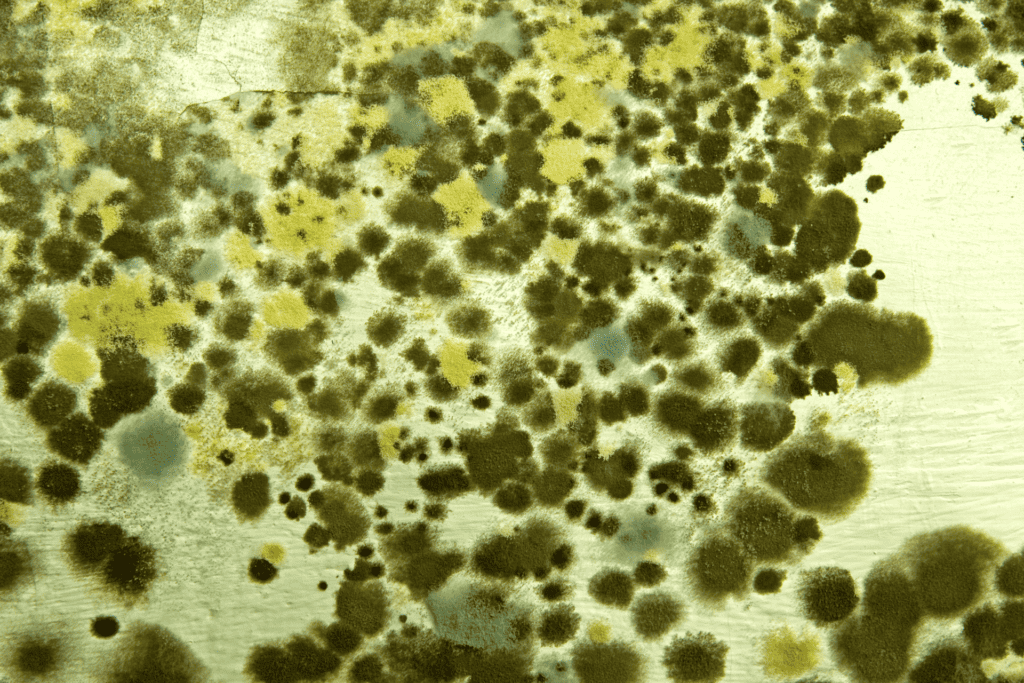Mold vs Mildew - What's the Difference?
After spotting some signs of mold in your home, you may’ve stumbled upon the term “mildew” when searching for mold removal services or articles on how to deal with mold on your own.
Now, you may wonder what mildew is and what the difference is between mold and mildew.
In this guide, we’ll explore what both mold and mildew are, what differentiates them, and how to deal with each.
Let’s get going!

What is Mold
Mold, in the context of biology, refers to a type of fungus. Fungi are a diverse group of microorganisms that can be found in various environments.
Mold is a specific type of fungus that typically grows in multicellular, filamentous structures known as hyphae. These hyphae can form a visible, fuzzy mass on surfaces, which is what we commonly recognize as mold in homes (like in the picture above).
Mold can grow on a wide range of organic materials, such as wood, paper, fabric, and food. It thrives in environments with moisture and can be found both indoors and outdoors. While some molds are harmless, others can produce allergens, irritants, or mycotoxins that can be harmful to human health.
What is Mildew
Mildew is a type of mold, specifically a surface mold, that typically appears as a powdery or downy growth on materials like plants, fabrics, paper, or walls. It is also often associated with damp or humid conditions.
Mildew can come in various colors, including white, gray, or black, and it can be unsightly and potentially damaging to the materials it grows on.
Unlike other molds that penetrate the surface of the material they are growing on, mildew typically remains on the surface. It can be found indoors in areas with typically high humidity, such as bathrooms, basements, and kitchens, as well as outdoors on plants, wood, and other surfaces exposed to moisture.
Difference Between Mold and Mildew
Appearance
The primary difference in the appearance of mold and mildew is their color and texture:
- Mold:
- Mold can appear in various colors, including black, green, blue, brown, or white.
- It typically has a fuzzy or slimy texture.
- The appearance of mold can vary depending on the specific type and the surface it’s growing on.
- Mildew:
- Mildew is usually white or gray in color.
- It typically has a powdery or downy texture.
- Mildew’s appearance is relatively consistent and is often found on plant surfaces or in damp indoor areas like bathrooms.
In summary, mold can come in a wider range of colors and has a fuzzy or slimy texture, while mildew is typically white or gray and has a powdery texture.
Growth Conditions
Now, let’s go over their growth conditions, because they can easily vary:
- Moisture: Both mold and mildew thrive in moist environments, but they have different moisture preferences. Mold typically requires higher moisture levels to grow, with a preference for moisture levels above 60%. Mildew, on the other hand, can grow in lower moisture conditions, often in the range of 40-60%.
- Temperature: Both mold and mildew can grow at a wide range of temperatures, but some mold species tend to prefer cooler temperatures, while mildew typically thrives in warm and humid conditions. Mold can grow in temperatures as low as 32°F (0°C), while mildew usually prefers temperatures between 77-88°F (25-30°C).
- Substrate: Mold is more likely to grow on a variety of porous and organic materials, such as wood, drywall, and ceiling tiles. Mildew, on the other hand, is commonly found on flat surfaces like shower tiles, bathroom grout, and fabrics.
- Air Circulation: Mold tends to thrive in areas with poor air circulation, such as behind walls, in basements, and in areas with high humidity. Mildew is often found in areas with better air circulation, like bathrooms and kitchens.
- Light Exposure: Mold is less sensitive to light and can grow in both dark and well-lit areas. Mildew tends to develop in areas with less exposure to direct sunlight.
Health Risks
Finally, onto the most important aspect of both mold and mildew: how harmful can each of them be for your health?
Here are some key things to note:
- Mold Health Risks:
- Respiratory Problems: Some molds, especially black mold (Stachybotrys chartarum), can produce mycotoxins that, when inhaled, may cause severe respiratory problems, including coughing, wheezing, and exacerbation of asthma symptoms.
- Allergies: Mold spores can trigger allergic reactions in susceptible individuals. Common symptoms include sneezing, a runny or stuffy nose, itchy or watery eyes, and skin rashes.
- Infections: People with weakened immune systems or certain underlying health conditions may be at risk of fungal infections from exposure to molds.
- Mildew Health Risks:
- Allergies: Mildew can also trigger allergic reactions, but these are typically milder and less severe than those caused by certain molds. Symptoms are very similar to those of mold-caused allergic reactions – sneezing, a runny nose, and skin irritation.
In summary, the key difference in terms of health risks is that certain molds, especially black mold, can produce mycotoxins that pose a greater health threat compared to mildew.
Mildew is generally less harmful to health, although it can still cause allergic reactions in some individuals.
How They Are Removed
The post Mold vs Mildew – What’s the Difference? first appeared on Vetted Los Angeles Restorations.
from Vetted Los Angeles Restorations https://ift.tt/VBGeSJp

No comments:
Post a Comment